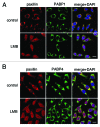An integrated model for the nucleo-cytoplasmic transport of cytoplasmic poly(A)-binding proteins
- PMID: 22896784
- PMCID: PMC3419106
- DOI: 10.4161/cib.19347
An integrated model for the nucleo-cytoplasmic transport of cytoplasmic poly(A)-binding proteins
Abstract
Cytoplasmic poly(A)-binding proteins (PABPs) regulate mRNA stability and translation. Although predominantly localized in the cytoplasm, PABP proteins also cycle through the nucleus. Recent work has established that their steady-state localization can be altered by cellular stresses such as ultraviolet (UV) radiation, and infection by several viruses, resulting in nuclear accumulation of PABPs. Here, we present further evidence that their interaction with and release from mRNA and translation complexes are important in determining their sub-cellular distribution and propose an integrated model for regulated nucleo-cytoplasmic transport of PABPs.
Keywords: PABP; PABPC1; PABPC4; RNA-binding protein; cellular stress response; nucleo-cytoplasmic transport; sub-cellular localization; translation initiation factor.
Figures





Similar articles
-
Poly(A)-binding proteins and mRNA localization: who rules the roost?Biochem Soc Trans. 2015 Dec;43(6):1277-84. doi: 10.1042/BST20150171. Biochem Soc Trans. 2015. PMID: 26614673 Review.
-
Nuclear relocalisation of cytoplasmic poly(A)-binding proteins PABP1 and PABP4 in response to UV irradiation reveals mRNA-dependent export of metazoan PABPs.J Cell Sci. 2011 Oct 1;124(Pt 19):3344-55. doi: 10.1242/jcs.087692. J Cell Sci. 2011. PMID: 21940797 Free PMC article.
-
Crossing the borders: poly(A)-binding proteins working on both sides of the fence.RNA Biol. 2010 May-Jun;7(3):291-5. doi: 10.4161/rna.7.3.11649. Epub 2010 May 27. RNA Biol. 2010. PMID: 20400847 Review.
-
Nuclear and cytoplasmic poly(A) binding proteins (PABPs) favor distinct transcripts and isoforms.Nucleic Acids Res. 2022 May 6;50(8):4685-4702. doi: 10.1093/nar/gkac263. Nucleic Acids Res. 2022. PMID: 35438785 Free PMC article.
-
Poly(A)-binding proteins: multifunctional scaffolds for the post-transcriptional control of gene expression.Genome Biol. 2003;4(7):223. doi: 10.1186/gb-2003-4-7-223. Epub 2003 Jul 1. Genome Biol. 2003. PMID: 12844354 Free PMC article. Review.
Cited by
-
Stress-induced Eukaryotic Translational Regulatory Mechanisms.ArXiv [Preprint]. 2024 May 2:arXiv:2405.01664v1. ArXiv. 2024. Update in: J Clin Med Sci. 2024;8(2):1000277. PMID: 38745702 Free PMC article. Updated. Preprint.
-
Multiple Posttranscriptional Strategies To Regulate the Herpes Simplex Virus 1 vhs Endoribonuclease.J Virol. 2018 Aug 16;92(17):e00818-18. doi: 10.1128/JVI.00818-18. Print 2018 Sep 1. J Virol. 2018. PMID: 29925667 Free PMC article.
-
Translational arrest and mRNA decay are independent activities of alphaherpesvirus virion host shutoff proteins.J Gen Virol. 2024 Apr;105(4):001976. doi: 10.1099/jgv.0.001976. J Gen Virol. 2024. PMID: 38572740 Free PMC article.
-
Stress-Induced Eukaryotic Translational Regulatory Mechanisms.J Clin Med Sci. 2024;8(2):1000277. Epub 2024 Jun 24. J Clin Med Sci. 2024. PMID: 39364184 Free PMC article.
-
Specificity factors in cytoplasmic polyadenylation.Wiley Interdiscip Rev RNA. 2013 Jul-Aug;4(4):437-61. doi: 10.1002/wrna.1171. Wiley Interdiscip Rev RNA. 2013. PMID: 23776146 Free PMC article. Review.
References
Grants and funding
LinkOut - more resources
Full Text Sources
